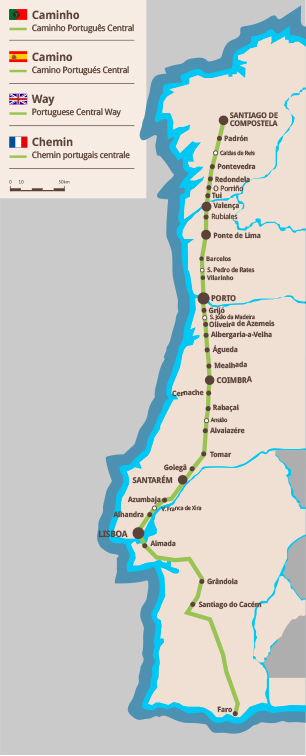Stages 50 : Start in Faro
![]()
In this Portuguese central route towards Santiago de Compostela, we will find cities of great beauty, natural resources and unique gastronomy.
The North of Portugal, the cradle of Portuguese identity, preserves an architectural and unique landscape heritage, starting in the old noble Invicta City of Oporto, internationally recognized for its high level of architectural and historical heritage, as well as its unique character of strong traditions implemented in its people (warm, welcoming and proud of their city).
Besides its population, this city is the home of monuments of important symbolism, such as the Church and Tower of Clérigos, monument of baroque inspiration of the 18th century, designed by Nicolau Nasoni and Ex Libris of the city. Other important heritage sites as the Cathedral of Porto (preserves the cult to the apostle Santiago), the Bolsa’s Palace, the Church of St. Francisco, the Don Luís bridge; the gardens of the Crystal Palace and the monastery of Serra do Pilar, in which you can feel a lived, passionate and resistant past.

In Portugal and Spain it is possible to observe different architectural styles, from Romanic, Gothic, Manueline, Renaissance, Baroque, Art Deco to contemporary times, always involving to natural beauties. Caldas de Reis and Pontevedra are known for their thermal waters and Spanish hospitality is well known as the saying goes “Pontevedra gives those who go there something to drink.”
Tui, one of the seven capitals of the Old Kingdom of Galicia, of medieval nature and known for its religious character, motivates those who pass by to visit and pray in the Gothic Cathedral of Santa María; in the Convent of Clarisas and in the Gothic church of St Domingo, without forgetting to rest in Porriño, where the beauty of the local government building is an inspiration for those who want to follow their way to Santiago de Compostela, stopping at Padrón, which, like its pepper, “it can sting your spirit, or not.”


